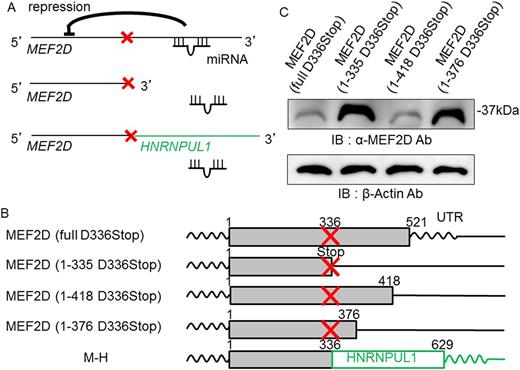Abstract
We previously discovered new fusion genes, MEF2D-BCL9 and MEF2D-HNRNPUL1, in 9% of adolescent and young adult B-cell acute lymphoblastic leukemia (ALL; Yasuda T, et al. , Nature Genetics, 2016;48:569-574). Vector driving expression of MEF2D-fusion protein was markedly higher than the expression of wild-type MEF2D (MEF2D W) protein driven by the same expression vector system; however, the mechanism and significance of the high-expression have been yet to be clarified.
We first confirmed fusion specific MEF2D high expression was occurred in MEF2D fusion-positive ALL cell lines, Kasumi-7 and Kasumi-9. Protein half-life and the effect of proteasome inhibitor on protein expression were not significantly different between MEF2D W and MEF2D-fusion, suggesting that stability of protein was not different between them. We speculated that MEF2D fusion gene lost the miRNA target that existed in C-terminal half of MEF2D mRNA and that the high-expression of MEF2D fusion protein was caused by escaping from the suppression by miRNA (Figure A). In order to investigate this speculation, we made several expression vectors of MEF2D that express same partial MEF2D protein but transcript different length of mRNA. That is, we introduced a mutation substituting stop codon for D336, the breakpoint of MEF2D-HNRNPUL1 fusion protein, into the expression vector of wild-type MEF2D and designated it as MEF2D (full D336Stop). We deleted C-terminal legion from it with various lengths (Figure B). The protein expression level of MEF2D (1-335) from MEF2D (full D336Stop) vector was similar to that of MEF2D W; however, the protein expression level was markedly increased when DNA region coding amino acid (aa) 377-418 was deleted from the expression vector (Figure C), indicating that protein expression of MEF2D (1-335) was down regulated by miRNA targeting mRNA coding aa 377-418. We identified a candidate of responsible miRNA by database search. Transfection of miRNA mimic of the candidate miRNA decreased the protein expression of MEF2D W but not that of MEF2D fusion. Introduction of mutation at the binding site of the candidate miRNA increased the protein expression of MEF2D W. We examined the effect of MEF2D fusion protein on transcriptional activity of various B cell differentiation regulators and found that MEF2D-fusion protein suppressed transcriptional activity of PAX5 in luciferase assays in dose-dependent manner and that MEF2D W protein did not significantly affect it. These results suggested that the high-expression of MEF2D fusion protein impaired B cell differentiation through the inhibition of PAX5 function. This is the first report that a mutation of a coding gene causes high expression of the protein coded by the gene through escape from suppression by miRNA. These results shed a new insight into the mechanism of leukemia development by MEF2D fusion gene and pathological significance of miRNA-related disorder.
Naoe: Otsuka Pharmaceutical Co.,Ltd.: Honoraria, Research Funding; Nippon Boehringer Ingelheim Co.: Honoraria, Research Funding; Fujifilm Corporation: Patents & Royalties, Research Funding; Dainippon Sumitomo Pharma Co.,LTD.: Research Funding; Astellas Pharma Inc.: Research Funding; Toyama Chemikal Co.,Ltd.: Research Funding. Kiyoi: Bristol-Myers Squibb: Honoraria, Research Funding; Nippon Shinyaku Co., Ltd.: Research Funding; Meiji Seika Pharma Co.,Ltd.: Research Funding; Zenyaku Kogyo Co., Ltd.: Research Funding; MSD K.K.: Research Funding; Celgene Corporation: Consultancy, Research Funding; Kyowa Hakko Kirin Co., Ltd.: Research Funding; Chugai Pharmaceutical Co., Ltd.: Research Funding; Eisai Co., Ltd.: Research Funding; Sumitomo Dainippon Pharma Co., Ltd.: Research Funding; Nippon Boehringer Ingelheim Co., Ltd.: Research Funding; Astellas Pharma Inc.: Consultancy, Research Funding; JCR Pharmaceuticals Co.,Ltd.: Research Funding; Novartis Pharma K.K.: Research Funding; FUJIFILM Corporation: Patents & Royalties, Research Funding; ONO Pharmaceutical Co., Ltd.: Research Funding; Phizer Japan Inc.: Honoraria, Research Funding; Takeda Pharmaceutical Co., Ltd.: Research Funding.
Author notes
Asterisk with author names denotes non-ASH members.


This feature is available to Subscribers Only
Sign In or Create an Account Close Modal